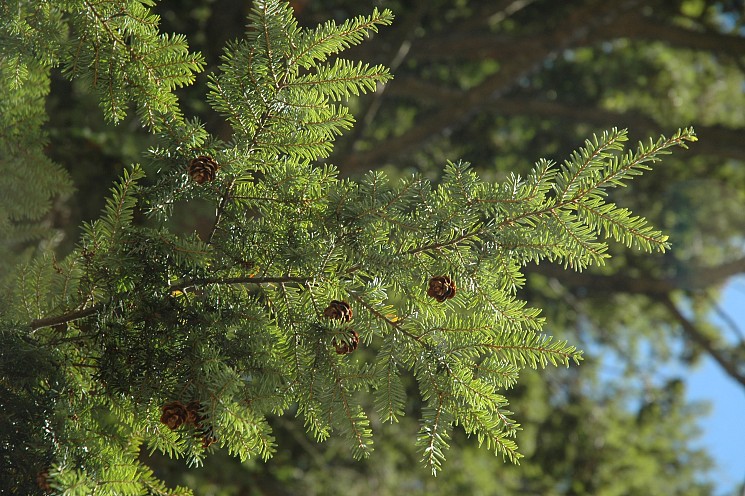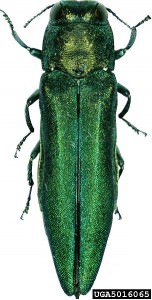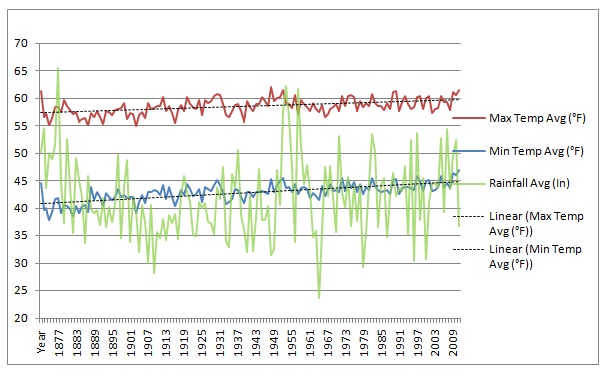Preserving our Tree Collection

Growing up on a farm in Oregon’s Willamette Valley, I spent late summers among over 50 acres of producing filbert orchard (Corylus avellana cultivars). But driving through the area a few years ago, I didn’t see a single standing tree. Eastern Filbert Blight, a fungus that attacks these nut trees, had struck the valley in the late 1980’s and eradication of the infected trees became the only control option available to growers in the region.
This winter, my first as Mount Auburn’s Plant Records Manager, I spent my time compiling data for the annual Plant Collections Analysis report. I thought about those filbert orchards as I worked and how much they have changed in my lifetime. And I thought about how Mount Auburn’s living collections are managed, and how they can be protected for the future. Many of the factors that precipitated the loss of those orchards: insects, diseases and climate change should be monitored here for potential threats.
Mount Auburn Cemetery has aggressive plans for dealing with insects like the Hemlock Wooly Adelgid which can cause the death of Canadian Hemlock (Tsuga canadensis), a stately conifer that graces the grounds. A program is in place for managing the beech tree collection (Fagus sylvatica) for another fungal pathogen, and of course many American Elm trees (Ulmus americana) were lost to Dutch Elm Disease in the 1970’s. On the horizon are insects like Emerald AshBorer (already in Connecticut and moving closer to us every year), new and destructive diseases like sudden oak death, and invasive plants that are expanding into the Northeast region. Climate change and ever-more-erratic weather promises to challenge the management programs in place that maintain the Cemetery’s celebrated tree collection.
From my perspective, climate change will be responsible for a greater percentage of our tree losses in the future. A warming climate means the end of low winter temperatures that can kill the Hemlock Woolly Adelgid. Kudzu is a warm weather vine that strangles everything in its path and has already moved as far north as isolated communities near Ontario, Canada. In addition, most scientists believe climate change is responsible for more severe and erratic weather such as “Super-storm” Sandy. Previous weather events such as the 1938 New England Hurricane which left a, “tangled mass of uprooted and broken trees” including 811 of Mount Auburn’s trees destroyed, and 1203 damaged, illustrate what kind of destruction is possible (1938 annual report). Saturated ground and flooding from heavy rains can lead to trees drowning; periods of drought can cause incredible stress to trees and make them susceptible to pests and disease, or outright kill them.
I contacted the Northeast Regional Climate Center and requested Cambridge and Boston area weather data dating back to 1872, the date of their earliest complete weather records. Looking at the data, it is clear that we are in a warming trend. The average yearly maximum temperature has risen about 3 degrees Fahrenheit over the past 140 years. And the average yearly minimum temperature has risen even more; about 4 degrees Fahrenheit. Average yearly rainfall (approximately 42” per year) fluctuates wildly from year to year; we have to expect both droughts and floods.
In 1996, Mount Auburn instituted a computerized plant records database. Since that year, database records show that the Cemetery averages 57 tree removals per year because of disease, environmental stress (such as drought), natural disaster and insect pests. In March of 2013, the National Weather Service Director Louis Uccelline hypothesized that climate change is, “making it more likely that the storms are more intense and produce heavier precipitation.” Beyond direct and obvious storm damage, the USDA Forest Service specifically calls out what climate change can mean to trees:
* Prediction of disease outbreaks will be more difficult in periods of rapidly changing climate and unstable weather, because altered reproduction and spread of forest tree pathogens will influence changes in initiation, development and severity of diseases.
* Host resistance to pathogens may be overcome as trees become stressed or as pathogens’ evolution accelerates more quickly than their long-lived hosts.
* Warmer winters will contribute to greater overwintering success of pathogens and/or associated insects, leading to increasing disease occurrence and severity.
USDA: Forest Tree Diseases and Climate Change
All of these factors point to the potential of losses for Mount Auburn Cemetery’s tree collection. But what can be done to help mitigate these issues? Reducing carbon footprints, just as Mount Auburn has done through programs like recycling, using energy efficient lights, and managing water usage, is a major step in the right direction to help mitigate climate change. Still, Mount Auburn’s staff will need continuing education in the latest pest and disease trends that are likely to strike the collection. Proper arboricultural practices are necessary to alleviate soil compaction, improve soil health, remove competing turfgrass around highly valued trees, and for disease scouting. Planning ahead to replace expected tree losses, like the Ashes (Fraxinus species), with non-susceptible species is the type of proactive action essential for the Cemetery to persevere as an arboretum. Mount Auburn is not planting new Ash trees because of the Emerald Ash Borer threat, and can further this effort by continuing diversification of tree types on the grounds. Preparing replacement trees through greenhouse propagation has been made much easier in the new greenhouses.
Moving forward into an uncertain climatic future, it will be imperative that Mount Auburn’s staff continue their vigilant care of the collections. Maintaining current high standards of care which have guided us since our founding 1831 will ensure that the tree collection will continue to inspire for the next 180 years.
This article was first published for the “Eternally Green” column in the Friends of Mount Auburn’s monthly electronic newsletter.


Leave a Reply